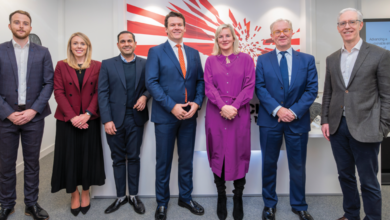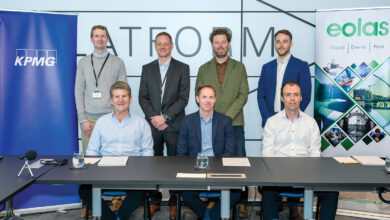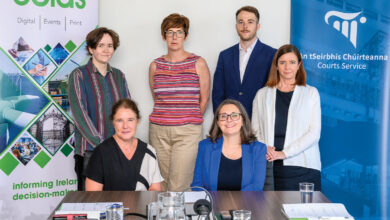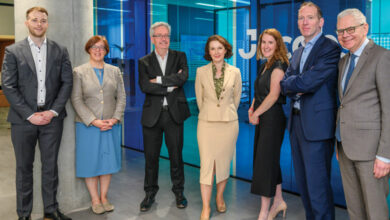The future of mobility

EY Ireland hosted a round table discussion with key stakeholders from across the transport sector on the future of mobility in Ireland.
Round table discussion hosted by
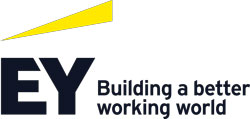
What are the most pressing priorities for Irish mobility today?
Ferga
Kane
The integration of our different transport systems and the improvement of flexibility for users has been a key priority and this needs to continue. We must also continue to focus on giving the road network its due significance, recognising the integral role it plays in commercial mobility while considering how we can attract users out of the car where they have viable alternative options. Finally, sustainability and ensuring we are building a sustainable transport system is an over-arching priority. Sustainability is key in relation to both climate change and the environment and also the social/user benefits and economic elements of our transport system.
Anne
Graham
Our immediate priority is keeping public transport services operational and available for customers. The Covid-19 response saw a fall in passenger demand and that has raised challenges around fare revenue, which accounts for around 65 per cent of the costs of operating services. Additional government funding has been a requirement to keep services operational. With the extension of support to those commercial license services operating in many of our towns, we’re also getting that funding to those operators to get those services back up and running. We’re also assessing the demand for travel come September, with the reopening of schools, which will enable us to estimate the cost of operating services and gauge the level of subsidy we will need to keep those running. Additionally, the social distancing requirement has encouraged local authorities to rethink mobility in towns and village centres and so we’re funding a lot of projects in relation to the widening of footpaths and development of protected cycle lanes.
Ray
O’Leary
We recognise that a balance is required between the short, medium and long-term priorities. Currently our focus is on maintaining the services operated by the Department and supporting the Road Safety Authority (RSA) to operate their services. Equally, we’re working with the National Transport Authority (NTA) on the investment in roads and helping local authorities to adapt to a shift in a wider range of active travel. At the same time, we’re looking long-term at sustainable development. We have a challenging Programme for Government and a challenging climate change agenda and we’re also trying to respond in the context of increasing digitisation, electrification and connectivity to play our part in economic recovery plans.
Seamus
Egan
The Luas was designed to take people out of their cars. One of the most pressing priorities for us is supporting the NTA and Transport Infrastructure Ireland (TII) in avoiding a car-led recovery. The current signs are that car usage has recovered quicker than any form of public transport has. As transport operators, working with other operators and the authorities, we need to strategically address the perception of public transport with regards to safety in relation to Covid-19.
Cathal
Masterson
We’re at mid-80 per cent levels of usual traffic volume on the road network so the financial pressures we envisaged in terms of decline in toll revenues which fund the operation and maintenance of the network might not be as severe as we initially feared. We’re also trying to keep pace with longer term trends such as increased public transport, more shared mobility and demand responsive services and to ensure that we prioritise the customer at the heart of our systems as they evolve.
Niall
Hogan
For ESB ecars, our immediate priority was to keep our network of 1,100 charge points across the island operational for those who needed it. Demand in the network fell by over 50 per cent in the weeks following Government restrictions. Our construction works in upgrading and expanding the network which had been paused during the height of restrictions have recommenced in line with government guidelines.
“One of the most pressing priorities for us is supporting the NTA and Transport Infrastructure Ireland (TII) in avoiding a car-led recovery. The current signs are that car usage has recovered quicker than any form of public transport has.”
Seamus Egan
Paul
Pierotti
Covid-19 will remain a part of our society and will influence our behaviours for the foreseeable future. Any outlook on the future of mobility will have to balance the need to ensure an operational transport network but also the likelihood of a prolonged reduction in demand, where only essential use should be encouraged.
What do you think will be the lasting impact of Covid-19 upon patterns of mobility?
Anne
Graham
We’re tracking these trends constantly and Covid has seen a complete change in mobility patterns. The major change has been office workers working from home, which has almost eradicated the morning peak, often the basis of any transport system. We think working from home will continue, although not to the same extent, meaning a reduction in demand at peak time. However, long-term we believe travel demand will still grow and so we still require the major projects we have been planning for as part of the National Development Plan programme.
We’ve also been tracking mobility patterns in other cities where they have high levels of sustainable transport. In Copenhagen, for example, the return to the car has gone beyond pre-Covid levels and we’re concerned that Dublin and our other cities would follow these patterns. To counteract that we must improve the perception of public transport as a safe means of travel. We’re not yet sure whether increased walking and cycling levels will transfer into the commuter travel but it’s something we’re monitoring, recognising the opportunity that exists should the demand be there.
Ray
O’Leary
Crises tend to accelerate existing trends and one of the challenges we face is establishing which trends are purely responsive to Covid-19 and may rebound and which ones will continue to accelerate; and to plan accordingly. Mobility patterns have shifted towards localised movement and we’re assessing how we can build on that and optimise this movement with land use planning, recognising that less than half of all travel is actually commuter based. What we don’t want to do is create different patterns of unsustainable mobility. Co-operation and recognition of the value of data will be important policy tools.
Ferga
Kane
Data is hugely important but it’s fundamental that the user is at the heart of future mobility plans. While looking at the data we must also look behind it to understand the consumer behaviours that drive actions. A huge uplift in walking and cycling in the early stages of the pandemic were recognised but I’ve been surprised by how quickly cars have returned to the road, even with the majority of office workers still working from home. So, there’s a communication element in how we counteract this trend to ensure that people aren’t easing back into their cars because it’s convenient.
Niall
Hogan
In a very short space of time we recognised improvements in air quality and noise pollution reduction from the abandonment of petrol and diesel cars. I think that people have seen that big change is possible in a short period of time and I’d like to see a situation where customer choice would be a move to cleaner transport to sustain some of that pace of change but without the huge personal and economic cost that Covid involved. Failure to achieve this will mean another type of crisis in the not too distant future.
“Local authorities are heavily involved in the re-imagination of public space and the road system, which I hope will aid us when we further develop the BusConnects system and in our consultations to develop more sustainable transport.”
Anne Graham
Cathal
Masterson
Changing consumer behaviours are also interesting, in terms of mobility including for instance the rise in online commerce which is changing logistics and transport and which may also change how our urban centres function. We need to keep on top of all of these inter-related trends to ensure we’re encouraging the good and supressing the bad.
What opportunities now exist for enhanced sustainability transport?
Seamus
Egan
The level of data that we are collecting and analysing, as well as the levels of collaboration that has been established between the authorities and the transport operators is unprecedented. Coming out of this we will have much better and more timely information about customer travel patterns and that presents opportunity. As a nation, we should be focussed on mobility as a core consideration of any development. Hopefully we’ll learn from having to retrofit mobility within the current transport environment and place mobility at the core of future developments.
Ray
O’Leary
The new scope of the ministerial portfolio, combining the energy, sustainability and communications agendas, is both a challenge and an opportunity. We’re working across boundaries with stakeholders to enhance our shared policy objectives to ride the wave of technological change and to extract the social and economic benefits. It’s important to note that sustainability is not just about the environment, though it’s a critical element. Sustainability revolves around the social and economic impact of mobility as well. A sustainability focus requires a look above the vehicle or mode, at system sustainability and user sustainability. The question is: what impact is our transport and mobility system having on the quality of the life of the citizen? It’s a challenge but we can make progress through collaboration and the pooling of perspective and knowledge.
“I’d like to see a situation where customer choice would be a move to cleaner transport to sustain some of that pace of change but without the huge personal and economic cost that Covid involved.”
Niall Hogan
Ferga
Kane
Opportunities exist as we seek to design sustainable mobility systems in response to evolving regulatory requirements, particularly around our focus on decarbonisation in response to the Climate Action Plan. The social outcomes of a sustainability focus, including connectivity, are very important and must be weighted equally with financial considerations. Operational sustainability is also key; the need to manage energy efficiency is becoming increasingly important across the transport network as is better resilience and greater responsiveness. These are all challenges, but they present myriad opportunities for innovation as we seek to enhance the sustainability of our transport system and network.
Niall
Hogan
It’s widely accepted that the electrification of transport is a key element of tackling climate change. We’re working to help drivers to make the choice towards clean transport. We’re doing our bit to accelerate that change by investing in and upgrading the public charging network for electric vehicles from passenger cars to commercial vehicles and electric buses.
Anne
Graham
People are beginning to view our road space differently and are having an input into the conversation on how the road network should be used for the most sustainable forms of transport. Local authorities are heavily involved in the re-imagination of public space and the road system, which I hope will aid us when we further develop the BusConnects system and in our consultations to develop more sustainable transport.
Cathal
Masterson
In TII, we’ve shifted our focus towards users and creating a much more multi-modal integrated transport network. One of our recent tolling data sets surprised me in that it showed buses to be the heaviest users of our tolling network, above haulage. Similarly, we found that women are more likely to drive and to drive to work than men. Better understanding of user behaviour and what’s going on on the network will help us develop the network going forward to meet all needs.
“Sustainability is key in relation to both climate change and the environment and also the social/user benefits and economic elements of our transport system.”
Ferga Kane
How is transport becoming smarter?
Paul
Pierotti
We have unprecedented access to a volume and breadth of data types across transport. Through the cloud, we are able to process this data for insights like never before. APIs also making it easier to connect different technologies and so enable unique and real time services. These combine to mean that we are in a position today to be able to deliver smart transport in Ireland.
There are three things we need to remember when reimagining our future smart transport system. Firstly, design services around the customer. Consumer demands continue to increase with new digital experiences. They enjoy a bespoke service from Spotify making recommendations based on usage and expect the same from others. We in transport need to recognise this expectation and build new, exciting services around the customer that also ignore organisational boundaries.
Secondly, share data to enable collaboration and innovation. There are many organisations involved in transport and there is a real opportunity to increase and improve cross working by sharing data. This will provide deeper insights around related issues and help design better solutions for all.
Thirdly, use these insights to intervene in real time. It is critical that these insights are embedded in front line services to provide targeted interventions and improve services. In most cases, that involves many targeted “nudges” to gently adjust behaviours towards the desired outcome. Make sure you thought through how you are going to industrialise such an approach in business as usual before going live.
Cathal
Masterson
There is more to be done on the data sharing side. We have been working with DTTAS on looking at the road haulage sector and pathways for decarbonising. While there are good options for passenger cars, haulage is a tricky sector and while there are pockets of very good data, it is not shared in a collaborative way across the sector, which means we don’t really know where the freight is travelling to and from on the network. There is a lot to work on going forward.
“Better understanding of user behaviour and what’s going on on the network will help us develop the network going forward to meet all needs.”
Cathal Masterson
Niall
Hogan
There are two sides of it: taking the technology from the vehicle side, the cost of batteries, and therefore electric cars, is coming down. The range of models and choice is increasing, which will make adoption much easier. You’re also seeing it move into areas that would have been seen as being technically challenging, such as the electric buses. It’s about the customer and citizen. The kind of smart behaviours we see in our ecar connect app are customers using the app to start and stop their charge, saving their favourite or most used chargers to make it more convenient for them, checking their usage patterns and bills. That’s what people expect now, easily operated accessible information that is useful and makes their lives easier.
Ray
O’Leary
One of our challenges is that users assimilate our improvements very quickly, so our benchmark keeps moving up. We have enhanced the operations of the National Vehicle and Driver File, which is the backbone now for not only our vehicle registration, motor tax and driver licensing systems but a range of other systems, notably the Garda mobility app and we’re working on a number of legislative and technical changes so that the Gardaí can get more and more information about a vehicle in real time. These changes will make life ultimately safer for citizens every day. Another backbone of which we share with the local authorities is a system called MapRoad, a geographical information system for local authorities that has all the data on local roads that is used for road openings etc. Those kinds of backbones are essential for central government to allow agencies to create the gateways for user interaction.
Anne
Graham
I agree that incremental changes are necessary, while the big projects are also in operation. We have been planning for the move to an account-based ticketing system, which will allow a much more flexible ticketing and pricing system; in the meantime we have developed a ticketing app which we are piloting at the moment, which is the move towards purchasing your ticket online and being able to display it on a mobile phone. We are beginning to understand more the benefit and the value of the data that we have in our organisation, both the ticketing and automatic vehicle location data. We use this for developing small improvements to the performance of operators in terms of punctuality and reliability. Customers are also looking for that level of information to be available to them daily when they are planning their trips to allow them to make a choice, particularly in this era when social distancing is still a concern. Transport is becoming smarter and we definitely want to make much more use of the data we have.
“We have a challenging Programme for Government and a challenging climate change agenda and we’re also trying to respond in the context of increasing digitisation, electrification and connectivity to play our part in economic recovery plans.”
Ray O’Leary
Seamus
Egan
We are currently about to trial a system called Flowly on the Luas. This a Transdev-owned technology where we will have sensors on trams providing us with real time data for passenger counts, demand and flow, the last of which will be new for us and very insightful. The system will be able to identify flow demands rather than just passenger numbers. We will also link this up with our fare collection system through an API that will give us an indicative rate of fare evasion. All the data and trends will have their greatest value extracted by collaboration between all operators and authorities.
Which specific investment will deliver the greatest transformation in Irish mobility?
Cathal
Masterson
We need to invest more time in cooperating and collaborating. Everything flows from that.
Seamus
Egan
Ireland has a boom and bust economy cycle and we should plan our major projects in that context. Irrespective of a bust, we need to plough ahead with planning and tendering and get to turning the sod. Even if it breaks down then, we’ll be ready to go the next time the economy picks up.
Ferga
Kane
We need to focus on investment in the greatest use of data, that will help us learn more around consumer behaviours. We do still need the big infrastructure investments, but we also need to focus on those quick wins to create a better service and have the users buy in more to the development of the system. Data can help unlock some of those quick wins.
Niall
Hogan
It may well be that the greatest transport investment is not transport at all, it’s fibre optic broadband, enabling all kinds of changes at societal level. Whatever investment we make, there is no silver bullet. It’s about showing customers that we can meet their needs through a number of modes with sustainable transport rather than unsustainable transport and making those sustainable choices easier for people.
“There are many organisations involved in transport and there is a real opportunity to increase and improve cross working by sharing data. This will provide deeper insights around related issues and help design better solutions for all.”
Paul Pierotti
Anne
Graham
BusConnects delivers for both bus and walking and cycling. It will have the biggest on-street impact in terms of changing the way people move around our cities. We need a bus system for our towns and cities that can be delivered in small steps for big return.
Paul
Pierotti
Collaboration through data is a wonderful place to start. It allows us to understand some of the multi-dimensional issues. For example, today we saw that women drive to work more often than men, which shows us some of the inherent biases in our systems. It’s about building that infrastructure where we can share, collaborate and innovate with our data.
Roundtable Participants
|
Seamus Egan has been Managing Director of Transdev since October 2018, having previously served as Performance Director and Contracts Manager. In December 2019 he oversaw the transition of Transdev to Luas operator and maintainer. Prior to Transdev he worked in the fields of mechanical and manufacturing engineering after beginning his career as an apprentice fitter/turner with Irish Rail. |
|
Anne Graham is the CEO of the National Transport Authority. Anne previously worked with the Authority as Director of Public Transport Services on the regulation and provision of public transport services nationally. Prior to joining the NTA, she worked in the Dublin local authorities as a chartered civil engineer in the drainage, roads and traffic divisions; as a project manager on the redevelopment of Dublin’s O’Connell Street area and as an Area Manager in the South West area of the city. |
|
Niall Hogan is Head of eMobility with ESB with responsibility for expanding and upgrading Ireland’s public EV charging network. He has previously held a variety of senior leadership roles in ESB including Group Strategy Manager, Finance Transformation Program Manager, Head of ESB’s Property function and General Manager of its external Telecoms business (ESBT). He is a Fellow of the Chartered Association of Certified Accountants (FCCA) with an MSc in Coaching from UCD. |

Ferga Kane Ferga Kane is a partner in EY’s Government and Infrastructure Advisory practice, a post she has held since July 2019. A UCD graduate, she has almost 20 years’ experience in advising public and private sector clients on the development and financing of large infrastructure projects across a wide range of sectors including education; social housing; justice; health; transport; water, waste and energy (traditional and renewable). |
|
Cathal Masterson is Head of Tolling and Emerging Mobility at Transport Infrastructure Ireland. He is a chartered civil engineer with an MSc in project management and prior to joining the Transport Infrastructure Ireland, he worked as a consultant with Jacobs Engineering and Booz Allen on a variety of transport projects for public and private sector clients. |
|
Ray O’Leary is Assistant Secretary in Ireland’s Department of Transport, dealing with road transport. His area covers the Department’s investment, policy and oversight roles in relation to roads, and a range of areas relating to road haulage, freight policy, road safety and regulation of traffic generally. He previously worked in the Tourism Division and, prior to joining the Department, worked in the Department of Finance and the Department of the Environment. |
|
Paul Pierotti is a Partner in EY’s Data Analytics and Emerging Technology practice. He previously worked as a Managing Director in Accenture Analytics, where he led the Irish practice across all industries. Prior to that, Paul led Accenture’s Government Analytics practice for the UK and Ireland. His client list covers Government, Financial Services, Utilities, Life Sciences and High Tech. |


